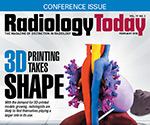 |
CT is top of mind this month, and we here at Radiology Today continue to be astounded at this modality’s trailblazing initiatives to improve lives, including the impressive precision 3D-printed ear implant technology recently announced via RSNA.
This month’s E-News Exclusive spotlights another side of the CT boom: an FDA-sanctioned application that can give health care professionals the upper hand and save precious time in the event a patient suffers a stroke.
— Dave Yeager, editor |
 |
 |
New Stroke-Detecting Software Gets FDA Nod
The FDA has approved marketing of the Viz.AI Contact application, a type of clinical decision support software designed to analyze CT results that may notify providers of a potential stroke in their patients. According to the Centers for Disease Control and Prevention, stroke is the fifth leading cause of death in the United States and is a major cause of serious disability for adults. About 795,000 people in the United States have a stroke each year.
“Strokes can cause serious and irreversible damage to patients,” says Robert Ochs, PhD, acting deputy director for radiological health at the Office of In Vitro Diagnostics and Radiological Health in the FDA’s Center for Devices and Radiological Health. “The software device could benefit patients by notifying a specialist earlier, thereby decreasing the time to treatment. Faster treatment may lessen the extent or progression of a stroke.”
The Viz.AI Contact application is a computer-aided triage software that uses an AI algorithm to analyze images for indicators associated with a stroke. AI algorithms are a type of clinical decision support software that can assist providers in identifying the most appropriate treatment plan for a patient’s disease or condition.
Full story » |
 |
 |
Ultrasound-Controlled Cancer Immunotherapy System Unveiled
Researchers have created a way to target and kill cancer cells remotely via ultrasound. The noninvasive approach makes it possible to remotely control genetic processes in live immune T cells to identify and kill cancer cells. Researchers used ultrasound to mechanically disturb T cells and then converted the mechanical signals into genetic control of cells, according to UC San Diego News Center.
CT Study Enables 3D Print of Dinosaur Skull
A PhD student at the University of the Witwatersrand in Johannesburg, South Africa, has used CT technology to peer inside the skull of the dinosaur Massospondylus. The digital reconstruction of the skull of the 200-million-year-old South African dinosaur, including intricate nerves and the inner ear, heralds the possibility of researchers creating 3D prints to improve paleontological research worldwide.
Brain Imaging Helps Redefine Intelligence
Functional MRI scans of the resting human brain can provide a new way to define and interpret the brain’s actual mental capacity, according to new research from New York University. Researchers used imaging technology to measure patients’ brains for entropy, the variety of nerve circuits used to interpret the surrounding world, and linked greater entropy to more versatile processing of information.
FDA: MRI Isotope Can Now Be Produced in the United States
The FDA has approved a new technology, the RadioGenix System, to produce a domestic supply of the imaging isotope Technetium-99m for the first time in more than 30 years. The development is being touted as stable, secure, and sustainable, in that it addresses supply-side concerns that have overshadowed US industries for decades. |
 |
|
|
 |
|
|
 |
 |
3D Printing Takes Shape
The demand for 3D-printed models is only growing, and radiologists promise to figure prominently as the awe-inspiring possibilities unfold. Read more »
Expanded Coverage
As legislation continues to influence radiology practice and manufacturers refine their products to stay ahead of the curve, CT is making a difference for radiologists in new and unexpected ways. Read more »
Balancing Act
Experts agree that even modest dose reductions can have a measurable impact on population health. To secure the best outcomes for patients and providers, best practices must figure prominently in the dose management discussion. Read more »
In the Flow: Part 1 — New Technology Helps Keep Radiology Work Flowing
In the first installment of a two-part series, we find out how radiology experts are staying ahead of their ever-growing quantities of imaging data and examine the ways artificial intelligence, cloud-based technology, and other innovations play heavily into their daily workflow. Read more » |
 |
|
